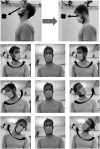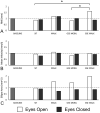The effect of selected rest break activities on reaction time, balance, and perceived discomfort after one hour of simulated occupational whole-body vibration exposure in healthy adults
- PMID: 37572647
- PMCID: PMC10424600
- DOI: 10.1080/07853890.2023.2244965
The effect of selected rest break activities on reaction time, balance, and perceived discomfort after one hour of simulated occupational whole-body vibration exposure in healthy adults
Abstract
Materials & methods: Eleven healthy adults participated in four 1-hour sessions of ecologically valid WBV exposure followed by one of four 5-minute activities: sitting, walking, 2 min of gaze stabilization exercise (GSE) coupled with 3 min of trunk mobility exercise (GSE + MOBIL), or 2 min of GSE coupled with a 3-minute walk (GSE + WALK). Baseline and post-activity measurements (rating of perceived discomfort, balance and postural sway measurements, 5-minute psychomotor vigilance task test) were submitted to a paired t-test to determine the effect of WBV exposure and activities on physical, cognitive, and sensorimotor systems and to a repeated measures ANOVA to determine any differences across activities.
Results: We observed degradation of the slowest 10% reaction speed outcomes between baseline and post-activity after walking (7.3%, p < 0.05) and sitting (8.6%, p < 0.05) but not after GSE + MOBIL or GSE + WALK activities. Slowest 10% reaction speed after GSE + MOBIL activity was faster than all other activities. The rating of perceived discomfort was higher after SIT and WALK activities. There were no notable differences in balance outcomes.
Conclusion: When compared to sitting for 5 min, an activity including GSE and an active component, such as walking or trunk mobility exercises, resulted in maintenance of reaction time after WBV exposure. If confirmed in occupational environments, GSE may provide a simple, rapid, effective, and inexpensive means to protect against decrements in reaction time after WBV exposure.
Keywords: Whole-body vibration; accident prevention; ergonomics; laboratory simulation; occupational exposure; reaction time.
Plain language summary
A 5-minute intervention activity after 1 hour of occupational whole-body vibration (WBV) exposure may provide protection against detriments in reaction time.Intervention activities that include a gaze stabilization exercise component maintained the slowest reaction speeds after 1 hour of WBV exposure, whereas sitting and walking activities resulted in a further slowing of the slowest reaction speeds.It may be possible for machinery operators to incorporate gaze stabilization activities in occupational environments, either in or out-of-cab, but further evaluation for feasibility and practicality of in-field adoption is required.
Conflict of interest statement
No potential conflict of interest was reported by the author(s).
Figures





Similar articles
-
The Multisystem Effects of Simulated Agricultural Whole Body Vibration on Acute Sensorimotor, Physical, and Cognitive Performance.Ann Work Expo Health. 2018 Aug 13;62(7):884-898. doi: 10.1093/annweh/wxy043. Ann Work Expo Health. 2018. PMID: 29905767
-
Effects of Whole-Body Vibration Training on the Physical Function of the Frail Elderly: An Open, Randomized Controlled Trial.Arch Phys Med Rehabil. 2020 Jul;101(7):1111-1119. doi: 10.1016/j.apmr.2020.02.009. Epub 2020 Mar 4. Arch Phys Med Rehabil. 2020. PMID: 32145279 Clinical Trial.
-
Whole-Body Vibration Intensities in Chronic Stroke: A Randomized Controlled Trial.Med Sci Sports Exerc. 2016 Jul;48(7):1227-38. doi: 10.1249/MSS.0000000000000909. Med Sci Sports Exerc. 2016. PMID: 26918558 Clinical Trial.
-
The after-effects of occupational whole-body vibration on human cognitive, visual, and motor function: A systematic review.Appl Ergon. 2024 Jul;118:104264. doi: 10.1016/j.apergo.2024.104264. Epub 2024 Apr 1. Appl Ergon. 2024. PMID: 38565009
-
Long-Term Effects of Whole-Body Vibration on Human Gait: A Systematic Review and Meta-Analysis.Front Neurol. 2019 Jun 19;10:627. doi: 10.3389/fneur.2019.00627. eCollection 2019. Front Neurol. 2019. PMID: 31316447 Free PMC article.
References
-
- Eger T, Stevenson J, Boileau PÉ, et al. . Predictions of health risks associated with the operation of load-haul-dump mining vehicles : part 1—analysis of whole-body vibration exposure using ISO 2631-1 and ISO-2631-5 standards. Int J Ind Ergon. 2008;38(9-10):1–16. doi: 10.1016/j.ergon.2007.08.012. - DOI
Publication types
MeSH terms
LinkOut - more resources
Full Text Sources
Other Literature Sources
